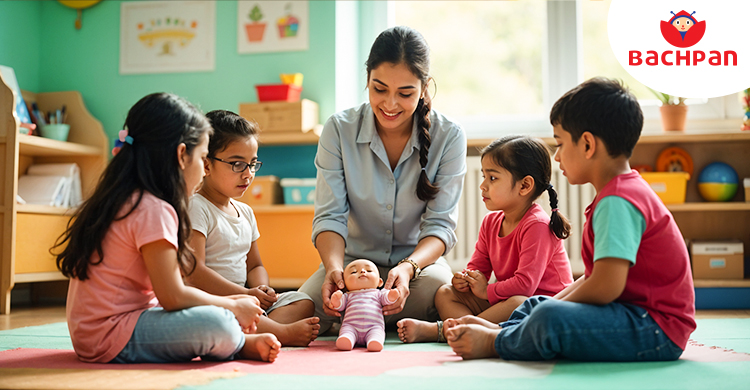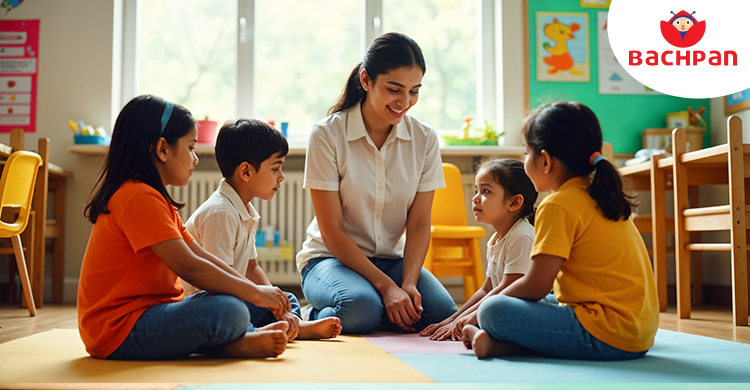How To Teach Good Touch And Bad Touch to Kids?

Parents often teach their children not to take anything from a stranger or never open a door when parents are not at home. Because a child’s safety is of paramount importance to every parent. So, educating children about personal boundaries from an early age is equally important. Making young ones aware and teaching them the difference between good touch and bad touch is crucial for their emotional and physical well-being.
What Is Good Touch and Bad Touch?
Good touch refers to affectionate and comforting interactions like hugs from family members, helping them feel loved and secure. Bad touch involves inappropriate or unwanted contact, which can cause discomfort or harm. Kids need to recognise the difference between both for their safety.
What Is Good Touch?
A touch that makes the child feel loved, safe, and protected is a good touch. Examples of good touch are holding hands with a parent while crossing the street and a comforting touch on the shoulder or a pat on the back from a teacher as a sign of appreciation.
What Is Bad Touch?
Bad touch involves any physical contact that makes a child feel uncomfortable, scared, or unsafe. This could include unwanted touching, like a forceful hug, touching their private parts, or actions like pinching, hitting, or grabbing that violate personal boundaries.
Why It’s Important to Teach Children About Touch
Teaching children about good and bad touch lays the foundation for healthy relationships and personal boundaries. It empowers them to speak up if they feel uncomfortable, prevents any harm, and helps them develop a strong sense of self-protection. Through this education, children also learn to trust their instincts and take appropriate action when faced with unsafe situations.
Visual Guide to Help your Child Understand Touch
Here is the visual guide that helps children understand the difference between safe and unsafe touch, empowering them to set boundaries, stay safe, and communicate confidently about personal safety.
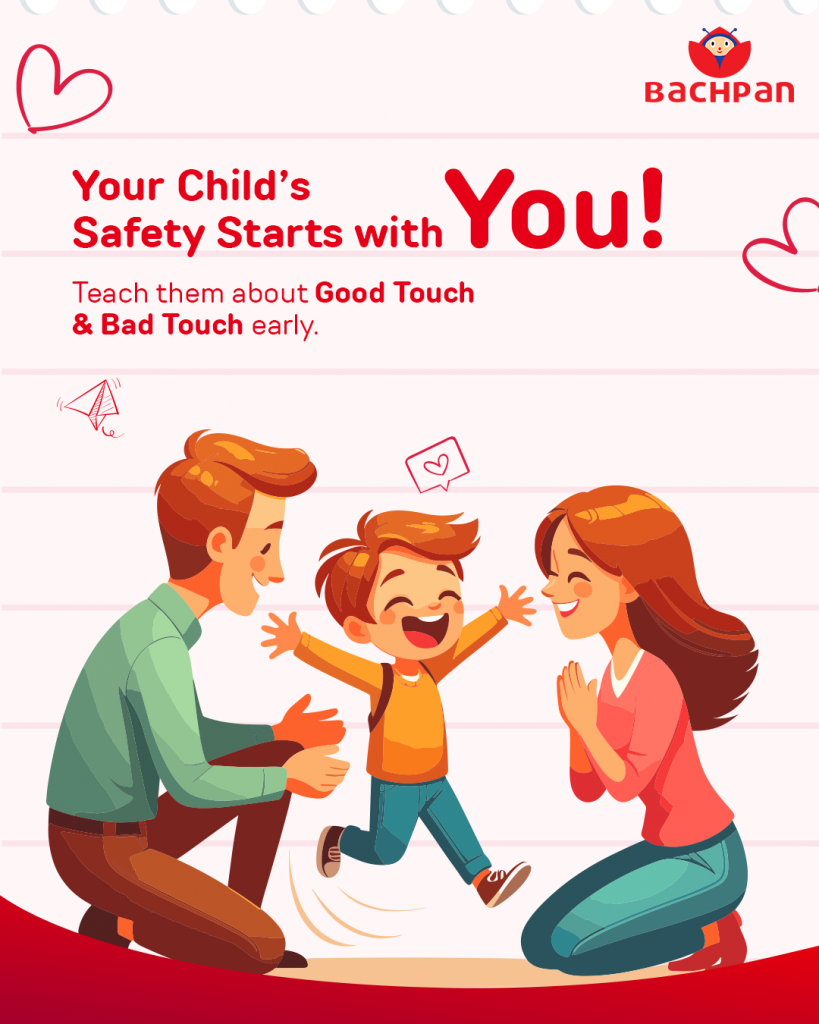
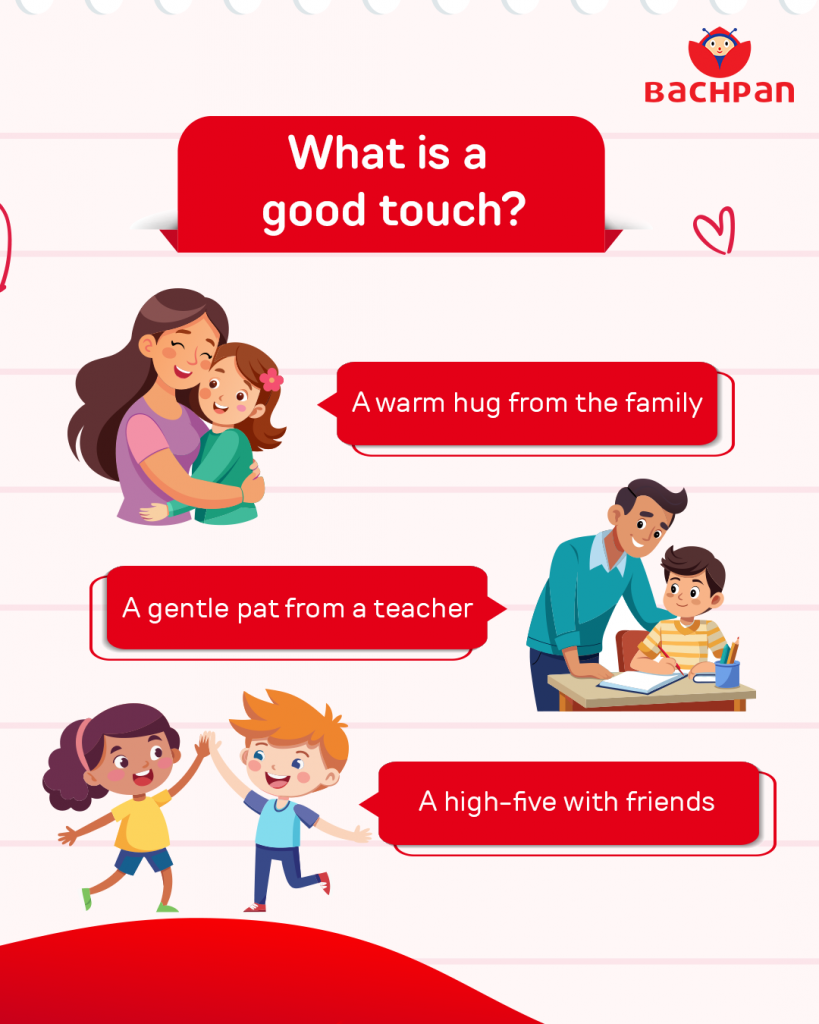
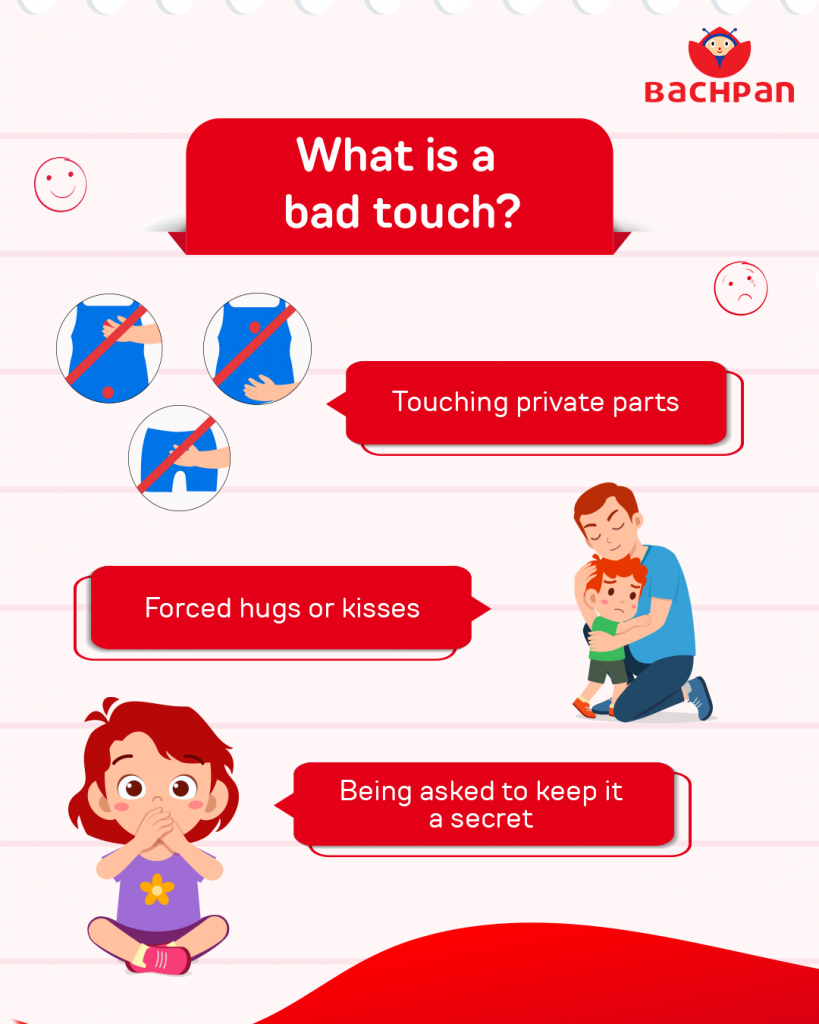
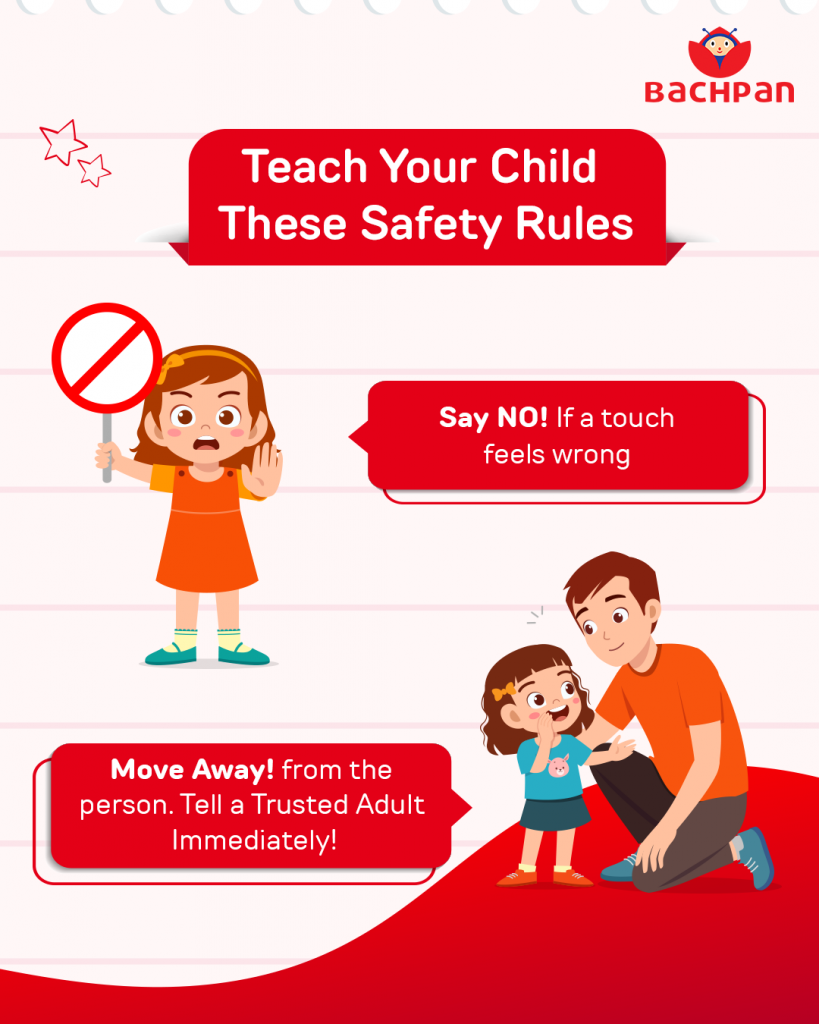
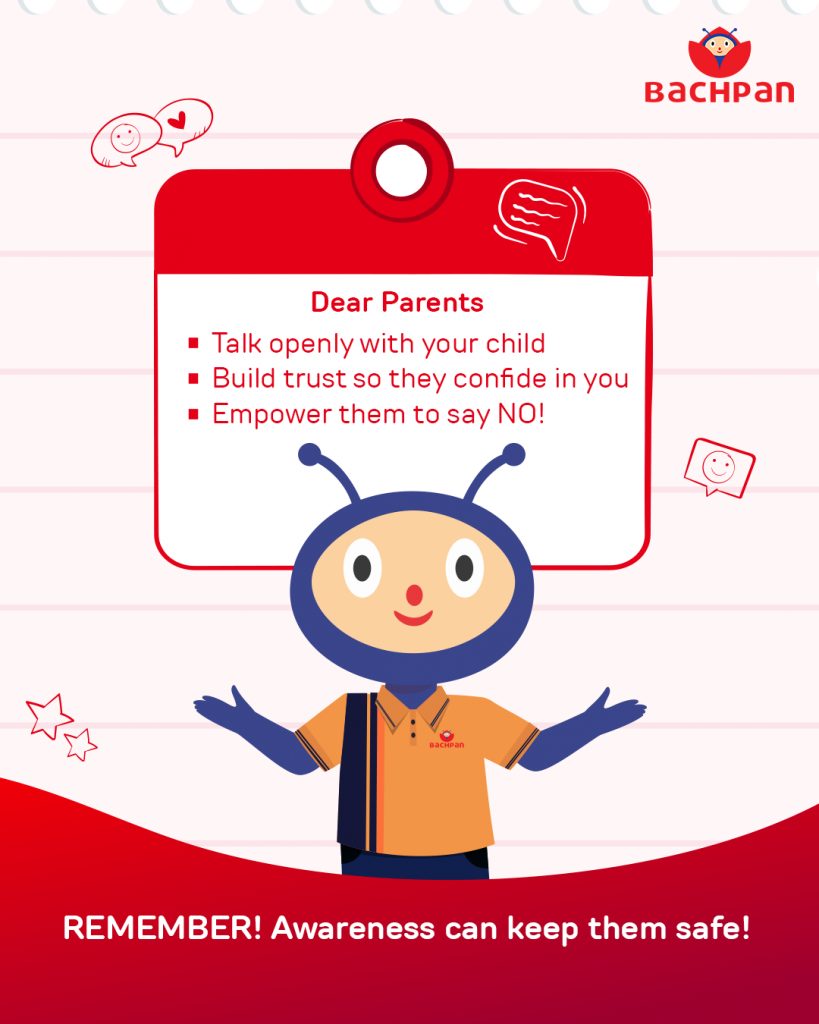
Practical Steps for Teaching Good Touch and Bad Touch
As it is a sensitive topic, it’s important to approach it in a thoughtful and age-appropriate manner. Start early with clear, simple conversations that can help children understand what’s appropriate and safe. Having these discussions regularly will help children recognise any threat around them and be better equipped to protect themselves.
Start Conversations Early and Age-Appropriately
It’s never too early to start talking about personal boundaries. Begin discussions with your child using simple language and age-appropriate words. Even young children can understand the difference between a friendly touch and one that scares them. Keep the conversation open and ongoing, so they feel comfortable seeking guidance when needed.
Use Books, Games, and Role-Playing
Taking the help of books, using flashcards that show images of different kinds of touches, and role-playing activities can make teaching good and bad touch more engaging for children. Visual aids and stories help children grasp these concepts and reinforce their understanding in a way that is less scary to them.
Encourage Children to Speak Up if They Feel Uncomfortable
Children need to know that they can always speak up if they feel uncomfortable about any touch. Encourage open communication by reassuring your child that they won’t be punished for expressing their feelings. Teach them that it’s okay to say “no” and that they should always tell a trusted adult if something doesn’t feel right.
Teach the Difference Between Secrets and Surprises
Children often struggle to differentiate between a surprise and a secret. It’s important to explain that surprises are fun and should be shared with others, but secrets, especially those that make them uncomfortable, should never be kept. Teach children that they should always share any secret that feels wrong with a trusted adult.
How Good Touch and Bad Touch Education Protects Children?
Teaching children about unsafe behaviour not only increases their awareness of inappropriate situations but also empowers them to set personal boundaries. It protects them from any potential risk of harm and ensures they are confident in protecting themselves.
Helps Children Identify Unsafe Situations
Educating children about good and bad touch helps them quickly identify when something is not right. When they understand the difference, they are more likely to recognise uncomfortable or inappropriate situations. This early recognition helps children avoid potential threats and seek help before any harm occurs.
Empowers Children to Set Boundaries
When children are taught to identify good and bad touch, they gain the ability to set personal boundaries. They learn that it is okay to assert their needs and say “no” if something feels uncomfortable. This sense of agency builds their confidence and encourages them to take charge of their personal safety.
Builds Confidence in Personal Safety
Teaching children about good and bad touch instils a sense of confidence in their ability to protect themselves. They become more self-aware and can take proactive steps to avoid dangerous situations. The knowledge that they can trust their instincts and assert boundaries gives children a greater sense of security and emotional well-being.
Creating a Safe Environment for Children
A safe environment is crucial for the well-being of children. By ensuring that children understand the concept of touch and can confidently speak out when something feels wrong, we can build a protective atmosphere where they feel valued, heard, and respected.
Build Trust Between Children and Carers
Trust is the foundation of any healthy relationship. To create a safe environment, carers must build trust by listening to their children’s concerns, respecting their boundaries, and offering reassurance. When children trust their carers, they are more likely to share their feelings and seek help when they feel unsafe.
Monitor and Supervise Interactions with Others
To protect children from harm, it is essential to monitor and supervise their interactions with others. This includes being aware of who they are interacting with, both at home and in external environments. Supervising their social interactions ensures that children are less likely to find themselves in harmful situations and that any danger is spotted early.
Collaborate with Schools and Childcare Providers
It is not just the responsibility of parents to educate kids about personal safety. Schools, childcare providers, and other carers need to have a consistent approach to teaching children about good touch and bad touch. These professionals can reinforce the lessons taught at home and offer additional support in creating safe spaces for children. When everyone is on the same page, children are better protected.
Conclusion
Children are the future of any nation. It is our duty to guide them to the right path and protect them. Teaching children about good touch and bad touch is a crucial step in ensuring their safety and well-being. Having open conversations and using various resources like books and role-play will help in building trust with children. With these methods, we can empower them to identify unsafe situations, set boundaries, and confidently speak up when needed. Ultimately, education and awareness help create a safer environment for children, allowing them to thrive emotionally and physically. Safeguarding their innocence today helps protect their future tomorrow.
At Bachpan Play School, we priorities not just academic learning but also the emotional and social well-being of every child. Our safe and nurturing environment ensures that children feel secure while exploring the world around them. Through age-appropriate lessons, interactive activities, and a strong support system, we help children understand personal safety and develop the confidence to express themselves. By working together with parents and carers, we create a foundation where children learn, grow, and feel protected every step of the way.




